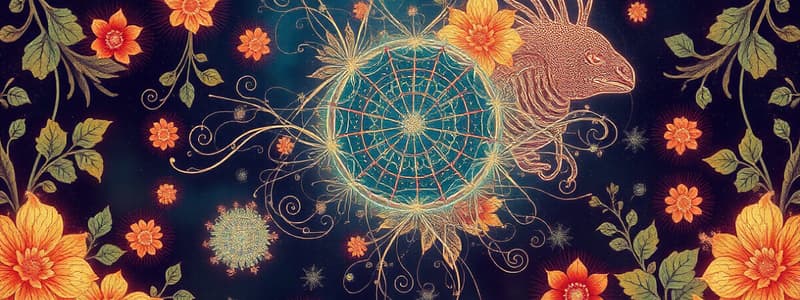Podcast
Questions and Answers
What best defines homeostasis in mammals?
What best defines homeostasis in mammals?
- The maintenance of a constant state in the internal environment. (correct)
- The ability of cells to reproduce rapidly and efficiently.
- A process that allows cells to become specialized for specific functions.
- The coordination of muscle movements in response to external stimuli.
Which is NOT a component of the homeostatic mechanism?
Which is NOT a component of the homeostatic mechanism?
- Glands that secrete hormones
- Central control that processes information
- Receptors that detect changes
- Mitochondria that generate cellular energy (correct)
What role do effectors play in homeostasis?
What role do effectors play in homeostasis?
- They coordinate responses to stimuli.
- They carry out responses to restore balance. (correct)
- They detect changes in the internal environment.
- They act as reservoirs for nutrients and waste.
How do the nervous and endocrine systems differ in their method of communication?
How do the nervous and endocrine systems differ in their method of communication?
What is the principle behind negative feedback in homeostatic mechanisms?
What is the principle behind negative feedback in homeostatic mechanisms?
What is the primary role of the afferent arteriole in the nephron?
What is the primary role of the afferent arteriole in the nephron?
What structures are formed from the merging of the glomerular capillaries?
What structures are formed from the merging of the glomerular capillaries?
Which process in the nephron primarily involves the removal of waste products from the blood?
Which process in the nephron primarily involves the removal of waste products from the blood?
How does the diameter of the efferent arteriole compare to that of the afferent arteriole?
How does the diameter of the efferent arteriole compare to that of the afferent arteriole?
What is the role of peritubular capillaries in the nephron?
What is the role of peritubular capillaries in the nephron?
Which kidney function is primarily involved in maintaining blood composition?
Which kidney function is primarily involved in maintaining blood composition?
What does the renal vein result from?
What does the renal vein result from?
What role does cyclic AMP play in enzyme activation?
What role does cyclic AMP play in enzyme activation?
What is the primary consequence of a low blood glucose concentration?
What is the primary consequence of a low blood glucose concentration?
Which hormone is primarily responsible for decreasing blood glucose levels?
Which hormone is primarily responsible for decreasing blood glucose levels?
What process converts excess glucose into glycogen?
What process converts excess glucose into glycogen?
How does the body maintain a stable blood glucose concentration?
How does the body maintain a stable blood glucose concentration?
What happens during gluconeogenesis?
What happens during gluconeogenesis?
What condition can occur if blood glucose levels rise too high?
What condition can occur if blood glucose levels rise too high?
Which type of protein is responsible for transporting glucose out of liver cells?
Which type of protein is responsible for transporting glucose out of liver cells?
What effect does phosphorylation have during enzyme cascades?
What effect does phosphorylation have during enzyme cascades?
What is the function of cyclic AMP in the hormone action mechanism?
What is the function of cyclic AMP in the hormone action mechanism?
Which of the following correctly describes a characteristic of hormones?
Which of the following correctly describes a characteristic of hormones?
In the context of hormone signaling, what is the first stage of the process for adrenaline?
In the context of hormone signaling, what is the first stage of the process for adrenaline?
What role does the G protein play in the mechanism of hormone action?
What role does the G protein play in the mechanism of hormone action?
Which of the following is NOT a characteristic of the endocrine system?
Which of the following is NOT a characteristic of the endocrine system?
During the stimulation of liver cells, what happens when adrenaline binds to its receptor?
During the stimulation of liver cells, what happens when adrenaline binds to its receptor?
What are the three main stages of cell signaling in the control of blood glucose by adrenaline?
What are the three main stages of cell signaling in the control of blood glucose by adrenaline?
Which hormone is mentioned as acting on liver cells to facilitate glucose conversion?
Which hormone is mentioned as acting on liver cells to facilitate glucose conversion?
What is the result of the enzyme cascade activated during hormone signaling?
What is the result of the enzyme cascade activated during hormone signaling?
Flashcards
Homeostasis
Homeostasis
The maintenance of a constant internal environment in an organism, despite changes in the external environment.
Internal Environment
Internal Environment
The internal environment of multicellular organisms, made up of fluids that bathe each cell to provide nutrients and remove waste.
Tissues
Tissues
Specialised groups of cells that work together to perform a specific function within an organism.
Organs
Organs
Signup and view all the flashcards
Organ Systems
Organ Systems
Signup and view all the flashcards
Afferent arteriole
Afferent arteriole
Signup and view all the flashcards
Glomerulus
Glomerulus
Signup and view all the flashcards
Efferent arteriole
Efferent arteriole
Signup and view all the flashcards
Peritubular capillaries
Peritubular capillaries
Signup and view all the flashcards
Ultrafiltration
Ultrafiltration
Signup and view all the flashcards
Selective reabsorption
Selective reabsorption
Signup and view all the flashcards
Urine formation
Urine formation
Signup and view all the flashcards
Glucose
Glucose
Signup and view all the flashcards
Blood glucose regulation
Blood glucose regulation
Signup and view all the flashcards
Insulin
Insulin
Signup and view all the flashcards
Glucagon
Glucagon
Signup and view all the flashcards
Glycogenolysis
Glycogenolysis
Signup and view all the flashcards
Gluconeogenesis
Gluconeogenesis
Signup and view all the flashcards
Blood glucose concentration
Blood glucose concentration
Signup and view all the flashcards
Transporter protein
Transporter protein
Signup and view all the flashcards
Cyclic AMP (cAMP)
Cyclic AMP (cAMP)
Signup and view all the flashcards
What is a hormone?
What is a hormone?
Signup and view all the flashcards
What is adrenaline?
What is adrenaline?
Signup and view all the flashcards
What is hormone-receptor interaction?
What is hormone-receptor interaction?
Signup and view all the flashcards
What is a hormone receptor?
What is a hormone receptor?
Signup and view all the flashcards
What is a second messenger?
What is a second messenger?
Signup and view all the flashcards
What is cyclic AMP (cAMP)?
What is cyclic AMP (cAMP)?
Signup and view all the flashcards
What is adenylate cyclase?
What is adenylate cyclase?
Signup and view all the flashcards
What is a kinase protein?
What is a kinase protein?
Signup and view all the flashcards
What is an enzyme cascade?
What is an enzyme cascade?
Signup and view all the flashcards
Study Notes
Homeostasis in Mammals
- Homeostasis is the maintenance of a stable internal environment.
- Organisms evolved to perform specialist functions, leading to interdependence of cells.
- Coordination systems (nervous and endocrine) are crucial for this.
- The internal environment (extracellular fluids) surrounds cells, providing nutrients and removing waste.
- Homeostasis ensures cells function despite external changes.
- Homeostasis maintains normal ranges of chemical composition, volume, and other features of blood and tissue fluid, allowing cells to operate normally.
- Homeostasis involves continuous fluctuations around a set point.
Importance of Homeostasis
- Enzymes and proteins are sensitive to pH and temperature changes.
- Variations affect enzyme efficiency or cause denaturation.
- Changes to membrane proteins affect substance transport across cell membranes.
- Water potential fluctuations cause cell shrinkage/swelling, hindering normal cell functions.
Control Mechanisms and Feedback
- Set point: Desired level of operation regulated by receptors.
- Receptor: Detects internal or external stimuli, signaling deviations from set point.
- Central Control: Coordinates information from various sources.
- Effector: Initiates actions to return the system to the set point.
- Feedback loop: Informs the receptor of the changes brought about by the effector.
- Negative feedback systems return the system to the set point rather than move further away from it.
- Positive feedback systems amplify a response.
Excretion and Kidney Structure
- Excretion: Removal of waste products of metabolism.
- Elimination: Removal of substances that weren't involved in metabolism (e.g., dietary fiber).
- Carbon Dioxide (CO2) and water are major excretory products of respiration.
- Urea is a nitrogenous waste product.
- Urea is produced in the liver from excess amino acids via deamination.
- Ammonia is a toxic byproduct of deamination, converted to urea.
- Three stages produce urea: Ammonia to ammonia/ urea to urea cycle.
- Other excretory substances: bile pigment, mineral salts.
Kidney Structure
- Fibrous capsule: Outer membrane protecting the kidney.
- Cortex: Outer region containing renal capsules, convoluted tubules, and blood vessels.
- Medulla: Inner region with loops of Henle, collecting ducts, and blood vessels.
- Renal pelvis: Funnel-shaped cavity collecting urine into the ureter.
- Ureter: Tube carrying urine to the bladder.
- Renal artery: Supplies blood to the kidney.
- Renal vein: Returns blood from the kidney.
- Nephrons: The functional units of the kidney, microscopic, tubular structures.
The Structure of the Nephron
- Renal (Bowman's) capsule: Cup-shaped structure surrounding the glomerulus.
- Glomerulus: Knot of capillaries filtering blood.
- Proximal convoluted tubule: Tubular structure with microvilli increasing surface area.
- Loop of Henlé: Hairpin-loop extending into the medulla.
- Distal convoluted tubule: Tubular structure with fewer capillaries compared to the proximal tubule.
- Collecting duct: Wide tube merging into the renal pelvis.
- Afferent arteriole: Vessel supplying blood to the nephron.
- Efferent arteriole: Vessel draining blood away from the nephron.
- Peritubular capillaries: Network around the tubules, reabsorbing substances.
Kidney Function – Ultrafiltration and Selective Reabsorption
- Ultrafiltration: High pressure forcing water, glucose, mineral ions, and other small molecules through the glomerulus, forming the glomerular filtrate.
- Selective reabsorption: Recovering useful substances (water, glucose, salts), from filtrate back into the blood stream in the proximal convoluted tubule and other parts of the nephron using active transport and diffusion.
Control of Water and Solute Concentration of the Blood
- Osmoregulation: Maintaining constant water and solute levels in the blood, using hormones.
- Osmoreceptors: Sensory cells detect changes in water potential in the blood.
- Antidiuretic hormone (ADH): Hormone secreted by the posterior pituitary, increasing water permeability in collecting ducts, returning water to the blood and producing concentrated urine.
- Osmoregulation is a feedback system reacting to changes in blood water potential.
Hormones and the Endocrine Glands
- Hormones: Chemical messengers secreted by endocrine glands and transported in the blood.
- Target cells: Cells with receptors to receive and respond to specific hormones.
- Cyclic AMP (second messenger system): Series of reactions amplifying a signal.
- Example: Adrenaline stimulating liver cells to convert glycogen into glucose.
Regulation of Blood Glucose
- Normal blood glucose concentration.
- Three sources: Direct from diet, breakdown of glycogen, gluconeogenesis.
- Insulin lowers blood glucose: Increasing cellular respiration, promoting glycogen formation.
- Glucagon raises blood glucose.
- Adrenaline: Increases blood glucose in times of stress or excitement.
- These hormones work antagonistically in a negative feedback system to regulate blood glucose.
Biosensors
- Biosensors: Devices using biological molecules (enzymes or antibodies) to detect specific chemicals.
- Example: Urine analysis for glucose, protein, and ketones can aid in diagnoses.
Studying That Suits You
Use AI to generate personalized quizzes and flashcards to suit your learning preferences.





